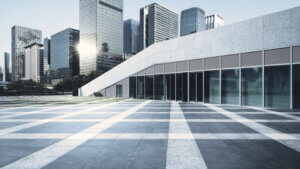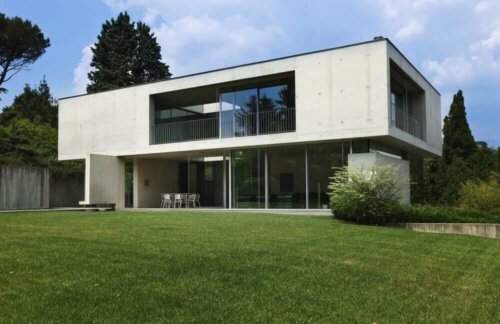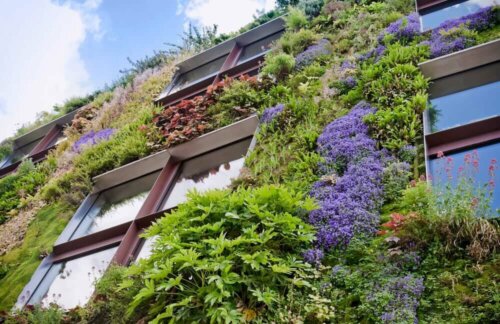Biological Concrete - The Material that Repairs Itself

Biological concrete is a material that’s at the forefront of construction, one of its best characteristics is that it’s self-repairing. This revolutionary material exists thanks to the Structures Technology Group of the Universitat Politècnica de Catalunya.
This is a response to the difficulty using vertical gardens on façades. These gardens are an excellent option to improve the energy efficiency of buildings however, they are often expensive and difficult to maintain.
Biological concrete is the result of the search for a better solution to vertical gardens to build “living” façades.
This material, which is also intended for the façades of some constructions, offers environmental, thermal, and decorative advantages. It’s an excellent option for sustainable architecture.
Sustainable architecture, with the application of this type of material, also seeks to improve urban environmental parameters.
Using biological concrete is a way of thinking about the proper management of resources and energy conservation and biological concrete is a sustainable construction material.
Biological concrete composition

The research team used two cement-based materials for the development of this new concrete. It used conventional carbonated concrete (based on Portland cement), obtaining a material with a pH value of 8.
The other material is made from a magnesium phosphate cement (MPC). This type of cement is a hydraulic binder that doesn’t require any treatment to lower the pH because it’s already slightly acidic.
The properties of MPC cement mean it’s also used as a bio cement in medicine and dentistry. This material has shown it doesn’t have a high environmental impact.
The innovation of biological concrete is it works as a natural support for the growth of certain biological organisms. These can be certain types of families of fungi, mosses, and lichens.
The research group focused on developing the best way to promote the growth of these organisms and tried to accelerate the growth process of organisms in biological concrete.
Revolutionizing concrete

This type of concrete becomes living concrete by allowing organisms to grow. The material, due to components such as cement, can easily crack, so it’s reinforced with steel.
In response to this cracking process, the living organisms that inhabit the biological concrete act on the fracture, occupying the space. Therefore, this type of concrete is self-repairing.
Considerable and larger fractures must be repaired with traditional methods. However, the biological concrete system considerably increases the life of buildings by repairing minor cracks.
Due to the high pH, it has, higher than 8, bacteria that live in these acidity levels, such as Bacillus often appear.
The great innovation of this biological concrete is its ability to grow and develop microalgae, fungi, lichens, and mosses in a natural accelerated way.
How does biological concrete repair itself?

The bacteria Bacillus repairs concrete when cracks appear. These bacteria can producing limestone, which fills the fractures progressively, sealing the material.
Living organisms can creating spores, and they’re resistant for decades without a problem. Spores are like sleeping bacteria that activate when there’s food and water around. This means they’ll activate and seal a crack if water can get into it.
This material isn’t only for new buildings, as it can also enhance restorative rehabilitation work. In addition, the research group points out the use of biological concrete in areas with high seismic activity to help make buildings safer.
With this innovative material, façades have changes in color at different times of year.
Biological concrete, in addition to being a material that repairs itself, is an excellent example of a sustainable material. The use of this revolutionary element doesn’t only improve the climatic conditions of buildings, but it’s also a great contribution to the urban environment.
Thanks for reading, we hope you’ve enjoyed this article.
Biological concrete is a material that’s at the forefront of construction, one of its best characteristics is that it’s self-repairing. This revolutionary material exists thanks to the Structures Technology Group of the Universitat Politècnica de Catalunya.
This is a response to the difficulty using vertical gardens on façades. These gardens are an excellent option to improve the energy efficiency of buildings however, they are often expensive and difficult to maintain.
Biological concrete is the result of the search for a better solution to vertical gardens to build “living” façades.
This material, which is also intended for the façades of some constructions, offers environmental, thermal, and decorative advantages. It’s an excellent option for sustainable architecture.
Sustainable architecture, with the application of this type of material, also seeks to improve urban environmental parameters.
Using biological concrete is a way of thinking about the proper management of resources and energy conservation and biological concrete is a sustainable construction material.
Biological concrete composition

The research team used two cement-based materials for the development of this new concrete. It used conventional carbonated concrete (based on Portland cement), obtaining a material with a pH value of 8.
The other material is made from a magnesium phosphate cement (MPC). This type of cement is a hydraulic binder that doesn’t require any treatment to lower the pH because it’s already slightly acidic.
The properties of MPC cement mean it’s also used as a bio cement in medicine and dentistry. This material has shown it doesn’t have a high environmental impact.
The innovation of biological concrete is it works as a natural support for the growth of certain biological organisms. These can be certain types of families of fungi, mosses, and lichens.
The research group focused on developing the best way to promote the growth of these organisms and tried to accelerate the growth process of organisms in biological concrete.
Revolutionizing concrete

This type of concrete becomes living concrete by allowing organisms to grow. The material, due to components such as cement, can easily crack, so it’s reinforced with steel.
In response to this cracking process, the living organisms that inhabit the biological concrete act on the fracture, occupying the space. Therefore, this type of concrete is self-repairing.
Considerable and larger fractures must be repaired with traditional methods. However, the biological concrete system considerably increases the life of buildings by repairing minor cracks.
Due to the high pH, it has, higher than 8, bacteria that live in these acidity levels, such as Bacillus often appear.
The great innovation of this biological concrete is its ability to grow and develop microalgae, fungi, lichens, and mosses in a natural accelerated way.
How does biological concrete repair itself?

The bacteria Bacillus repairs concrete when cracks appear. These bacteria can producing limestone, which fills the fractures progressively, sealing the material.
Living organisms can creating spores, and they’re resistant for decades without a problem. Spores are like sleeping bacteria that activate when there’s food and water around. This means they’ll activate and seal a crack if water can get into it.
This material isn’t only for new buildings, as it can also enhance restorative rehabilitation work. In addition, the research group points out the use of biological concrete in areas with high seismic activity to help make buildings safer.
With this innovative material, façades have changes in color at different times of year.
Biological concrete, in addition to being a material that repairs itself, is an excellent example of a sustainable material. The use of this revolutionary element doesn’t only improve the climatic conditions of buildings, but it’s also a great contribution to the urban environment.
Thanks for reading, we hope you’ve enjoyed this article.







